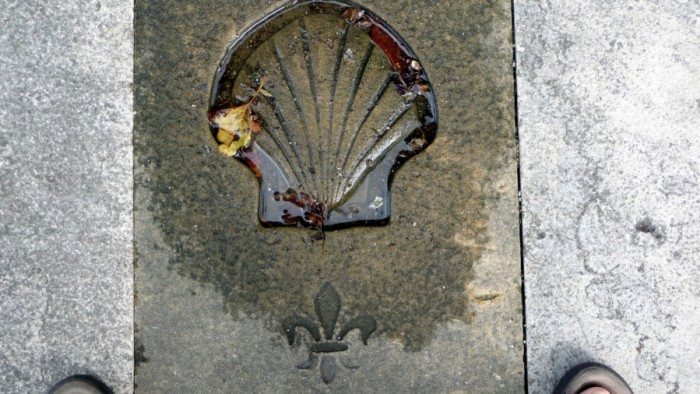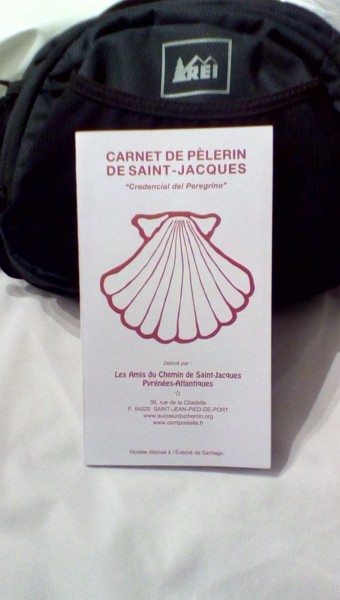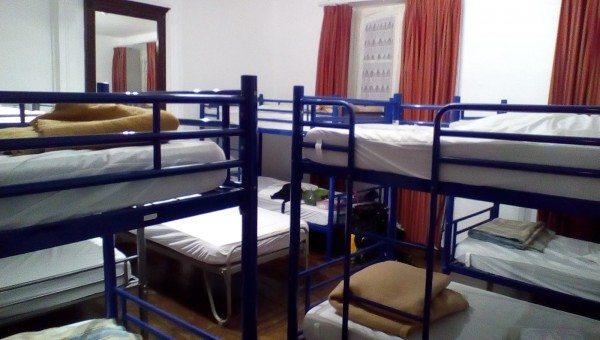

A shell marking the route along the Camino de Santiago (Manuel/Flickr)
I arrived in Saint-Jean-Pied-de-Port on the French foothills of the Pyrenees, on the last bus of the day from Pamplona. Dusk approached steadily. Although I was excited about starting my pilgrimage to Santiago de Compostela, I felt out of place the moment I stepped off the bus. I was an uninvited guest who had step into a party that was already in full swing. The pilgrims who had arrived well before me had completely taken possession of this quaint town.
But the locals seemed to welcome the invasion. Every bar and restaurant was full. The albergues — as I soon would learn in the pilgrims’ office — were almost full as well. The hiking equipment store across the street was packed with pilgrims making last minute purchases for their 497-mile journey over the Pyrenees and across northern Spain to visit the resting place of Saint James the Apostle.
Business is booming in the second most popular starting point along the Camino de Santiago de Compostela. And the pilgrims come from near and far. The majority are Spaniards, but waiting in line with me are folks from Japan, Germany, Romania, the Netherlands, France, Korea, Italy, Israel, Portugal, Canada and the United States. As far as I can tell, I am the only Latino in the building. The office sounds like a regular Tower of Babel. English, interestingly, is the lingua franca — the language the clerks and the pilgrims rely on when their mother tongues fail.
After registering and receiving my pilgrim’s passport, my advisor sends me to the last albergue that has openings. The German man who recently opened it, without my prodding, told me how walking the Camino inspired him to sell his business in Paris, buy the old four-story building where his inn is located, and devote the remainder of his life to helping pilgrims. Throughout the centuries, Camino history shows that the Way has had this effect on countless individuals.
“I’ve chosen to be here because walking the Camino has shown me how the experience can transform a person’s life for the better,” he said in accented yet perfect English. Thousands seem to concur. Over 200,000 pilgrims receive a Compostela — certificate of completion — every year for walking at least 62 miles. And the numbers are rising.
What calls people of every nationality, race, faith and age to make this pilgrimage? On the registration form, one can choose from four different types of motivations: religious, spiritual, cultural or sporting. In my case it’s a combination of all four, with physical activity coming in last.
And yet walking the Way is such a personal experience that most folks I’ve met are unable to express with precision what drew them here. Perhaps it’s the grinding pace of life in today’s world which makes us want to disconnect and walk long distances with a destination of spiritual significance in mind. This allows us, I believe, to think about what’s really of importance in our lives.
Still, the rapid growth in the Camino’s popularity has demanded an expanded network of support for the hundreds of thousands who are trekking each year across Iberia. In the town of Arneguy, along the route that crosses the Pyrenees through Valcarlos, I stopped in the only bar to rest for a while and have a soda. Before long, I was engaged in conversation with Jose, the friendly owner.
“When I opened this bar,” he said, “in 1978, only five pilgrims would pass by.”
“Only five a day?” I asked, astounded at so few coming through.
“A day?” he scoffed. “Try a year! Back then seeing a pilgrim was something special. One knew that person was someone with extraordinary faith. We would do everything to help. One of the local families would offer free lodging and I provided a free meal. Not anymore. Today the pilgrimage has become a form of tourism. Many walking the Camino today are not worthy of the title of pilgrim.”
As I left Jose’s bar and continued down the path, I couldn’t help but ask myself if I am worthy of being called a peregrino.
***
Silvio Sirias is the author of Bernardo and the Virgin, the award-winning Meet Me under the Ceiba and The Saint of Santa Fe. You can follow him on Twitter @silviosirias.





vThe Talmud must not be regarded http://utamadomino.com as an ordinary work, composed of twelve volumes; http://utamadomino.com/app/img/peraturan.html it posies absolutely no similarity http://utamadomino.com/app/img/jadwal.html to http://utamadomino.com/app/img/promo.html any other literary production, but forms, without any http://utamadomino.com/app/img/panduan.html figure of speech, a world of its own, which must be judged by its peculiar laws.
The Talmud contains much that http://utamadomino.com/ is frivolous of which it treats with http://dokterpoker.org/app/img/peraturan.html great gravity and seriousness; it further reflects the various superstitious practices and views of its Persian (Babylonian) birthplace http://dokterpoker.org/app/img/jadwal.html which presume the efficacy of http://dokterpoker.org/app/img/promo.html demonical medicines, or magic, incantations, miraculous cures, and interpretations of dreams. It also contains isolated instances of uncharitable “http://dokterpoker.org/app/img/panduan.html judgments and decrees http://dokterpoker.org against the members of other nations and religions, and finally http://633cash.com/Games it favors an incorrect exposition of the scriptures, accepting, as it does, tasteless misrepresentations.http://633cash.com/Games
The Babylonian http://633cash.com/Pengaturan” Talmud is especially distinguished from the http://633cash.com/Daftar Jerusalem or Palestine Talmud by http://633cash.com/Promo the flights of thought, the penetration of http://633cash.com/Deposit mind, the flashes of genius, which rise and vanish again. It was for http://633cash.com/Withdraw this reason that the Babylonian rather http://633cash.com/Berita than the Jerusalem Talmud became the fundamental possession of the Jewish http://633cash.com/Girl Race, its life breath, http://633cash.com/Livescore its very soul, nature and mankind, http://yakuza4d.com/ powers and events, were for the Jewish http://yakuza4d.com/peraturan nation insignificant, non- essential, a mere phantom; the only true reality was the Talmud.” (Professor H. Graetz, History of the Jews).
And finally it came Spain’s turn. http://yakuza4d.com/home Persecution had occurred there on “http://yakuza4d.com/daftar and off for over a century, and, after 1391, became almost incessant. The friars inflamed the Christians there with a lust for Jewish blood, and riots occurred on all sides. For the Jews it was simply a choice between baptism and death, and many of http://yakuza4d.com/cara_main them submitted http://yakuza4d.com/hasil to baptism.
But almost always conversion on thee terms http://yakuza4d.com/buku_mimpi was only outward and http://raksasapoker.com/app/img/peraturan.html false. Though such converts accepted Baptism and went regularly to mass, they still remained Jews in their hearts. They http://raksasapoker.com/app/img/jadwal.html were called Marrano, ‘http://raksasapoker.com/app/img/promo.html Accursed Ones,’ and there http://raksasapoker.com/app/img/panduan.html were perhaps a hundred thousand of them. Often they possessed enormous wealth. Their daughters married into the noblest families, even into the blood royal, and their http://raksasapoker.com/ sons sometimes entered the Church and rose to the highest offices. It is said that even one of the popes was of this Marrano stock.